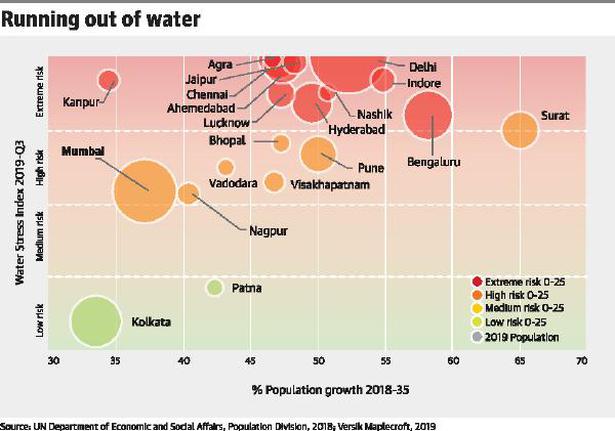Eleven of India’s 20 largest cities face an “extreme risk” of water stress, according to UK-based Verisk Maplecroft’s Water Stress Index. Delhi, Bengaluru, Hyderabad, Nashik and Jaipur are among the most vulnerable cities, with rapid population growth projected to deplete water resources by 2035. Chennai – whose four main reservoirs went dry last month – is now getting water from Vellore even as hotels and offices in the city ration water. The NITI Aayog has warned that 21 Indian cities could run out of groundwater by 2020.

The recent acute water shortage in Chennai has fuelled concerns that a potential water crisis is awaiting India’s large cities, which are grappling with the pressures of rapid population growth, depletion of water resources and adverse effects of climate change.
Tamil Nadu’s capital city did impose water cuts from June to conserve resources, but a prolonged dry spell caused its four main reservoirs to run dry. A train is now meeting the city’s needs by ferrying water every day from nearby Vellore. However, businesses in the city, like the vibrant auto industry, must find their own ways to deal with the crisis.
The new normal
The present plight of Chennai ‘could be the new normal for tens of millions of people’ living in the country’s big cities, according to new study on the water scarcity risks facing India.
The sub-national Water Stress Index, formulated by London-based risk analytics firm Verisk Maplecroft, lists India as the 46th highest risk country in the world. What’s more worrying is that 11 of India’s 20 largest cities face an ‘extreme risk’ of water stress and seven are in the ‘high risk’ category. According to the index, Delhi, Chennai, Bengaluru, Hyderabad, Nashik, Jaipur, Ahmedabad and Indore are among the cities facing ‘extreme risk’. The index measures the water consumption rates of households, industries and farm sectors and the available resources in rivers, lakes and streams.
Verisk Maplecroft plotted the index with projected population growth trends to rank the cities facing the biggest threat to their water resources. The index suggests that Bengaluru and Surat are experiencing the greatest surge in demand for water and are most at risk of facing scarcity. Chennai and Delhi are extremely vulnerable too, the paper notes. Moreover, increasing demand for water could lead to an economic crisis. The United Nations estimates that Delhi’s population will grow from 28 million people to above 43 million by 2035, a 52% rise, while Chennai will grow by 47% to top 15 million over the same period. The study says Chennai is the tip of the iceberg for India’s water stressed cities.
According to the report, “The average population growth rate among the 11 extreme risk cities is 49%; more than 127 million people will call them home by 2035.” Securing water resources will be an important consideration for businesses to ensure continuity in operations and for cities to fuel economic activity.
India is rated ‘high risk’ in the Climate Change Vulnerability Index, which suggests that effects of climate change like an ‘extended dry season’ would make matters worse for the country’s cities. The study says, “Many major Indian cities are projected to experience a higher number of consecutive drought days when precipitation is less than 1 mm. Bengaluru, for example, is expected to experience 5% increase in consecutive drought days by 2060, relative to the period from 1981 to 2005.”

No comments:
Post a Comment